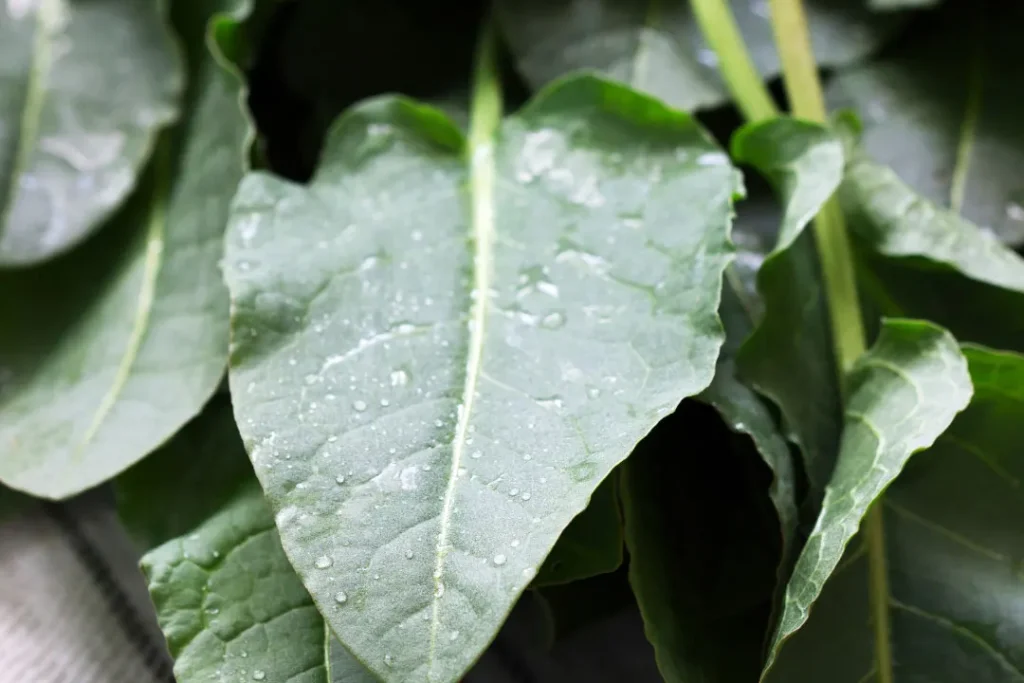Canaigre is a perennial plant that is native to the desert areas of the southwestern United States and northern Mexico. Its scientific name is Rumex hymenosepalus. Canaigre is a member of the Polygonaceae family, which are also known for its buckwheat plants. Canaigre is known for having wide, arrow-shaped leaves and for its unique color. Its roots are sturdy, tuberous, and a bright crimson color.
Native American tribes have long used these roots because they have high nutritional value and strong health benefits. Canaigre is steadily gaining popularity, especially due to the growth in people’s interest in nutritional supplements and herbal therapies throughout the world. This article aims to help you to understand the properties of canaigre, highlight its health advantages, and become aware of any possible adverse effects, medication interactions, and appropriate dosage.
You May Also Like:
5 Great Reasons to Try Alpha GPC for Brain Health
5 Great Health Benefits of ElevATP: From Increased Energy to Better Brain Function…
Nature of Canaigre
Canaigre, also known as Rumex hymenosepalus, is a desert-loving plant that is indigenous to northern Mexico and the southwestern United States. Its bulbous roots have a unique reddish tint and have wide, arrow-shaped leaves, making it a member of the Polygonaceae family. A more well-known plant of this category is buckwheat. The plant is known for its tenacity and hardiness, and is suited to flourish in dry environments.
Native American cultures have historically used its roots, which are high in tannins and oxalic acid, which are believed to have strong nutritional benefits. Canaigre is gaining more attention for its potential in the fields of nutrition and health as current scientific investigations continue to study the effectiveness of traditional plants.

Health Benefits of Canaigre
According to recent studies, canaigre intake has a number of health advantages, mostly due to its natural chemical ingredients.
The antioxidant qualities of tannins may aid in reducing oxidative stress, which is a physiological condition linked to many chronic illnesses, such as cancer, diabetes, and cardiovascular diseases. Antioxidants protect cellular integrity and function by scavenging dangerous toxins in the body.
Additionally, the anti-inflammatory properties of canaigre’s tannins can be helpful if you need a supplement that helps to better manage diseases like arthritis, inflammatory bowel disease, and other neurological problems that are linked to chronic inflammation.
The antibacterial properties of tannins and oxalic acid can help your body fight off bacterial, fungal, and viral diseases, which can result in enhancing your immune system health.
Last but not least, canaigre’s usefulness as a nutritional supplement is enhanced by its high mineral content. For example, potassium and calcium are necessary for nerve conduction, muscular contraction, and bone health. Iron is also crucial for hemoglobin production and your immune health.

Chemical Constituents of Canaigre
The effectiveness of Canaigre as a nutritional supplement is supported by its distinct chemical ingredients . Oxalic acid, various minerals, and tannins are a few of the main components.
Canaigre has a rich source of tannins, mainly the hydrolysable kind. Numerous physiological benefits of these polyphenolic substances include antioxidant, anti-inflammatory, antibacterial, and astringent qualities. Tannins are known for their capacity to bind proteins in our body, which helps with pathogen defense. This can also have an impact on digestion and metabolism.
Another key ingredient in canaigre is oxalic acid, which combines with certain minerals in our body to produce oxalates, an insoluble crystal. Oxalic acid is known to have antibacterial properties, but it is important to know that it can also lead to kidney stone development if you are prone to it.
Canaigre roots are a notable source for various necessary minerals, including calcium, potassium, and iron, which is what adds the nutritional value to the plant.

Physiological Properties of Canaigre
Canaigre’s physiological effects are mostly related to its high concentration of oxalic acid and hydrolysable tannins Due to their ability to attach to proteins, tannins have a variety of functions. By neutralizing damaging toxins floating around in our body, their antioxidant effect helps to prevent oxidative stress and maintain our cellular structures. . By modifying the body’s immunological responses, their anti-inflammatory properties , alleviates any problems linked to chronic inflammation. The antibacterial properties of tannins can aid in defense against a number of diseases while improving our immune system health.
Oxalic acid has antibacterial qualities in addition to being linked to various health concerns, like kidney stones. This can strengthen our body’s defenses against viral illnesses when paired with tannins’ antioxidant effects.
The high mineral content of the roots also add to the nutritional value of canaigre overall, and it supports a number of physiological attributes.
Optimal Dosage
A “one-size-fits-all” dose for canaigre has not yet been determined, partly because we all have our own unique physiology. Everyone’s health conditions can differ. It is essential to speak with your healthcare provider before starting this supplement.
Although canaigre use may provide you with great health benefits , there are concerns that can have an affect on you if you are not carefully informed. . Due to its high tannin and oxalic acid content, over ingestion can result in a variety of negative consequences. Due to tannin’s astringent impact, these may include gastrointestinal issues such nausea, vomiting, and diarrhea. Over time, consuming too much tannin can prevent your body from absorbing the nutrients.
If you are prone to kidney stones, the high oxalic acid level may be a a health concern since it may promote the production of oxalate crystals. Oxalic acid can also significantly lower blood calcium levels, which might result in hypocalcemia.

Side Effects of Canaigre
Canaigre may have some health advantages, but like other supplements, it can also have negative side effects.
Due to their astringent qualities, tannins may produce gastrointestinal problems such as nausea, vomiting, and diarrhea if you consume them in excessive amounts. High tannin consumption will also hinder the absorption of essential nutrients.
As previously mentioned, canaigre’s high oxalic acid concentration is a large concern if your body is prone to kidney stone production. Oxalate crystals can develop when oxalic acid consumption is high, which contributes to kidney stones. In severe circumstances, it may lower blood calcium levels.
Before beginning any supplement program, it is important to always get medical advice from your doctor, and keep a close eye out for any of these negative side effects.

Potential Substance Interactions
Due to the tannin ingredient in canaigre, several medications may interact with it. Tannins and other medicines may combine to produce complications, which may decrease the bioavailability and effectiveness of the medication. Certain antibiotics, non-steroidal anti-inflammatory medicines (NSAIDs), and antihypertensives are examples of medications with potentially harmful interactions. . It is advised to keep at least two hours in between taking these drugs and canaigre supplements as a prophylactic combination.
Responsible Use of Canaigre
Understanding both the advantages and the health concerns of canaigre is essential for responsible use. We strongly advise you to start taking supplements under the direction of a healthcare provider, who can also ensure the right dose. s. If you have certain medical problems or are using any other drugs, regular evaluations may be important to avoid unfavorable interactions.
Canaigre:
Conclusion
Canaigre is a rare but wonderful supplement to take due to its high quality, natural chemical ingredients. Considering that even Native American cultures have also relied on its vibrant roots for its benefits in the past, it is still beneficial and helps to improve our health and wellbeing to this day. However, like with any dietary supplements, it’s critical to weigh the advantages against any possible side effects or concerns, while also highlighting the need of safe, educated use. Canaigre’s reputation as a nutritional supplement is expected to improve and gain more popularity as research into it develops, offering a natural means of promoting health and wellbeing.
References:
- “Health Benefits and Side Effects of Canaigre. Retrieved From: https://www.webmd.com/vitamins/ai/ingredientmono-222/canaigre
- “Antioxidant and Anti-inflammatory Properties of Canaigre. Retrieved From: https://www.mayoclinic.org/xyz“
- Canaigre – Uses, Side Effects, and More Retrieved From:https://www.webmd.com/vitamins/ai/ingredientmono-222/canaigre
Important Note: The information contained in this article is for general informational purposes only, and should not be construed as health or medical advice, nor is it intended to diagnose, prevent, treat, or cure any disease or health condition. Before embarking on any diet, fitness regimen, or program of nutritional supplementation, it is advisable to consult your healthcare professional in order to determine its safety and probable efficacy in terms of your individual state of health.
Regarding Nutritional Supplements Or Other Non-Prescription Health Products: If any nutritional supplements or other non-prescription health products are mentioned in the foregoing article, any claims or statements made about them have not been evaluated by the U.S. Food and Drug Administration, and such nutritional supplements or other health products are not intended to diagnose, treat, cure, or prevent any disease.


